
Hodgson's hawk-cuckoo, also known as the whistling hawk-cuckoo is a species of cuckoo found in north-eastern India, Myanmar, southern China and southeast Asia.

The banded bay cuckoo or bay-banded cuckoo is a species of small cuckoo found in the Indian subcontinent and Southeast Asia. Like others in the genus they have round nostrils. They are usually founded in well-wooded areas mainly in the lower hills. Males sing from exposed branches during the breeding season, which can vary with region. They are distinctive both in their calls as well as plumage with a white eyebrowed appearance and the rufous upperparts with regular dark bands and the whitish underside with fine striations.

The common hawk-cuckoo, popularly known as the brainfever bird, is a medium-sized cuckoo resident in the Indian subcontinent. It bears a close resemblance to the Shikra, even in its style of flying and landing on a perch. The resemblance to hawks gives this group the generic name of hawk-cuckoo and like many other cuckoos these are brood parasites, laying their eggs in nests of babblers. During their breeding season in summer males produce loud, repetitive three note calls that are well-rendered as brain-fever, the second note being longer and higher pitched. These notes rise to a crescendo before ending abruptly and repeat after a few minutes; the calling may go on through the day, well after dusk and before dawn.

Cuculus is a genus of cuckoos which has representatives in most of the Old World, although the greatest diversity is in tropical southern and southeastern Asia.
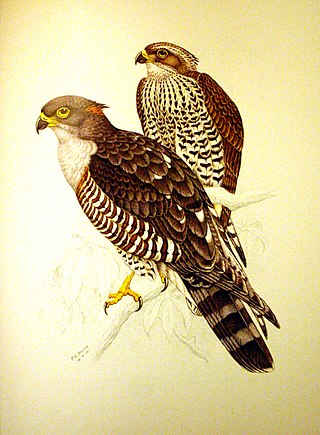
The African cuckoo-hawk, or African baza, is a medium-sized raptor in the family Accipitridae so named because it resembles the common cuckoo. It is found in sub-Saharan Africa and along the eastern parts of Southern Africa, preferring dense woodland and forest of either indigenous or exotic trees.
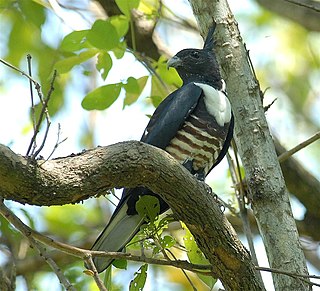
The bazas, Aviceda, are a genus of bird of prey in the family Accipitridae. The genus has a widespread distribution from Australia to southern Asia and across to Africa. The bazas are sometimes known as cuckoo-hawks. A prominent crest is a feature of the bazas. They have two tooth-like indentations on the edge of the upper bill.

The little bronze cuckoo is a species of cuckoo in the family Cuculidae. It is found in Southeast Asia, New Guinea and northern and eastern Australia, where its natural habitat is subtropical or tropical moist lowland forest. It is the world's smallest cuckoo, at 17 grams (0.60 oz) and 15 cm (6 in). The subspecies rufomerus and crassirostris are sometimes given specific status.

The large hawk-cuckoo is a species of cuckoo in the family Cuculidae. It has a wide breeding distribution from temperate Asia along the Himalayas extending to East Asia. Many populations winter further south. They are known for their loud and repetitive calls which are similar to that of the common hawk-cuckoo but do not rise in crescendo. They are also somewhat larger and adults can be readily told apart from the smaller common hawk-cuckoo by the black patch on the chin. They are brood-parasites of babblers and laughing-thrushes.
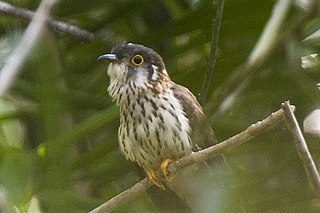
The moustached hawk-cuckoo is a species of cuckoo in the family Cuculidae. It is found in Brunei, Indonesia, Laos, Malaysia, Myanmar, and Thailand. Its natural habitat is evergreen and secondary forests. Threatened by habitat loss, it has been assessed as a near-threatened species.

The chestnut-breasted malkoha is a species of cuckoo in the family Cuculidae. Found in Southeast Asia from Myanmar through to eastern Java, the Philippines and Borneo, it is a large cuckoo measuring up to 49 cm (19 in) with grey and dark green upperparts and chestnut underparts, and a large curved pale upper mandible. The male and female are similar in plumage. Unlike many cuckoos, it builds its nest and raises its own young.

The ruddy cuckoo-dove is a species of bird in the family Columbidae. It is a medium-sized, reddish brown cuckoo-dove, found in Brunei, Indonesia, and Malaysia. It is rated as a species of least concern on the International Union for Conservation of Nature Red List of Endangered Species.

The little cuckoo-dove is a species of bird in the family Columbidae. It is a reddish brown pigeon, and is found in Brunei, China, Indonesia, Laos, Malaysia, Myanmar, Thailand, and Vietnam. It is rated as a species of least concern on the International Union for Conservation of Nature Red List of Endangered Species.
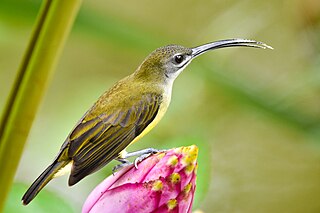
The little spiderhunter is a species of long-billed nectar-feeding bird in the family Nectariniidae found in the moist forests of South and Southeast Asia. Unlike typical sunbirds, males and females are very similar in plumage. They are usually seen in ones or twos and frequently make a tzeck call. They are most often found near flowering plants where they obtain nectar.

The chestnut-naped forktail is a species of bird in the flycatcher and chat family Muscicapidae. The species is monotypic, having no subspecies. It is found in Sundaland, in southern Burma and Thailand to Peninsular Malaysia, as well as Sumatra and Borneo. The species is not migratory.

The Philippine hawk-cuckoo is a bird belonging to the cuckoo family. It is found only in the Philippines. It was formerly classified as a subspecies of Hodgson's hawk-cuckoo but is now commonly treated as a separate species based on differences in vocalizations.

Hierococcyx or hawk-cuckoos is a genus of birds in the family Cuculidae. They are distributed in South, Southeast, and East Asia. The resemblance to hawks gives this group the generic name of hawk-cuckoos.
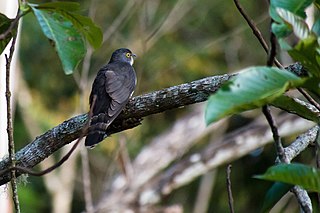
The dark hawk-cuckoo is a bird in the family Cuculidae formerly considered conspecific with the large hawk-cuckoo and placed in the Cuculus genus.

The northern hawk-cuckoo,rufous hawk-cuckoo, or Horsfield's hawk-cuckoo is a bird in the family Cuculidae formerly thought to be conspecific with Hodgson's hawk-cuckoo and placed in the genus Cuculus.
Taman Negeri Rompin or Rompin State Park is a state park located within Rompin District, in the state of Pahang, Malaysia. It spans an area of 31,797 hectares, consisting of lowland mixed dipterocarp forest, edaphic hill forest formation and rivers. The geological history of the park dates back at least 248 million years to the Permian-Carboniferous age, which the rock types include low grade metamorphics, igneous, granite and sedimentary sequence that has shaped the ecosystem within the protected area.


















